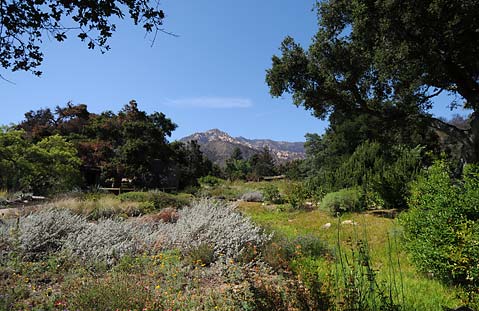Landmarks Panel Rebukes Botanic Garden Changes
County's Historic Landmarks Advisory Commission Sends Strong Letter to Planning Commission

Less than a week after the Santa Barbara Botanic Garden presented its Vital Mission Plan for future development to the County Planning Commission – an August 5 meeting that lasted nearly eight hours and will be continued on September 2 – the county’s Historic Landmarks Advisory Commission rebuked controversial changes to the garden’s landmark-protected 23 acres. On Monday, August 10, the HLAC decided to send a letter to the Planning Commission that, among other critiques, recommends the meadow terrace be removed, that there be no more paving of trails, and that the historic main entrance be re-opened.
The letter is the culmination of at least four separate HLAC hearings and hours of community input and debate. It was requested by county staff as a means of passing along HLAC’s opinion on the 23 historic acres to the Planning Commission, which is currently reviewing plans for the garden’s entire 78 acres. In general, HLAC does have authority to stop work on county landmarks, as it did when the meadow terrace project began in February 2008. But when it comes to the Botanic Garden’s Vital Mission Plan, any further HLAC action must await the Planning Commission’s certification of an environmental impact report. That certification could come as soon as the September 2 meeting.
HLAC’s John Woodward, who’s been following the garden’s plans for years and was involved in getting the 23 acres named a landmark in 2003, admits that trying to distinguish between the authorities wielded by the various bodies are confusing. He explained, “We’re in the awkward position of having had a lot of hearings, but can’t take any formal action.” While HLAC has the “jurisdiction to approve or deny something that is a change in the landmark,” Woodward said that the garden’s landmark status is a bit more unusual and challenging than the regular historic building. “It’s a unique landscape design concept,” he explained, which is defined as a system of “naturalistic” trails through native plant communities. “Anything that affects the landscape design concept is within the jurisdiction of the commission,” said Woodward, including the partially built meadow terrace, the proposed and current use of concrete pavers on the trails, and abandonment of the original entrance to the meadow as the major historic snafus.
Of the nine HLAC members, eight were present, and seven voted in favor of the letter. The lone dissenter was Deborah Schwartz, and Woodward explained that she only objected to the sentence that called for the complete removal of the meadow terrace, believing that there may be a compromise.
The garden is currently evaluating and crafting a response to the HLAC letter, explained spokesperson Nancy Johnson. “It seems HLAC wants to try and freeze the Botanic Garden – and more importantly plant science and horticulture – in a moment in time,” she explained. “Yet the reality is – and this is cited in the EIR – botanic gardens evolve. While there are historic buildings at the garden, there is no historic plan or layout. The garden’s displays and physical footprint have, again, continually changed and will continue to change.”
Presumably, the Planning Commission will give due consideration to HLAC’s critiques when they both certify the EIR and make their final decision on the project, because ignoring them will only prompt HLAC to flex its regulatory muscle. Said Woodward, “If they take action first, then we will come back and take our action.” Two of the most recent HLAC actions also involved the Botanic Garden’s meadow, and both – the stop work order on the meadow terrace and the approval of a temporary art structure – were appealed, the first by the garden, and the second by citizens. The Board of Supervisors supported the HLAC each time.
And all of this will most likely come down to the Board of Supervisors again, because no matter what HLAC says or the Planning Commission decides, the highly contentious and widely watched Botanic Garden matter is almost assuredly going to find its way to the county’s top decision makers. Evaluating both commissions’ decisions on their individual merits, the supervisors will then have the final say on the Vital Mission Plan, and that might not come until November or December of this year, if not later. “It’s gonna be quite an appeal hearing,” said Woodward.
Complete Botanic Garden coverage at independent.com/bg



